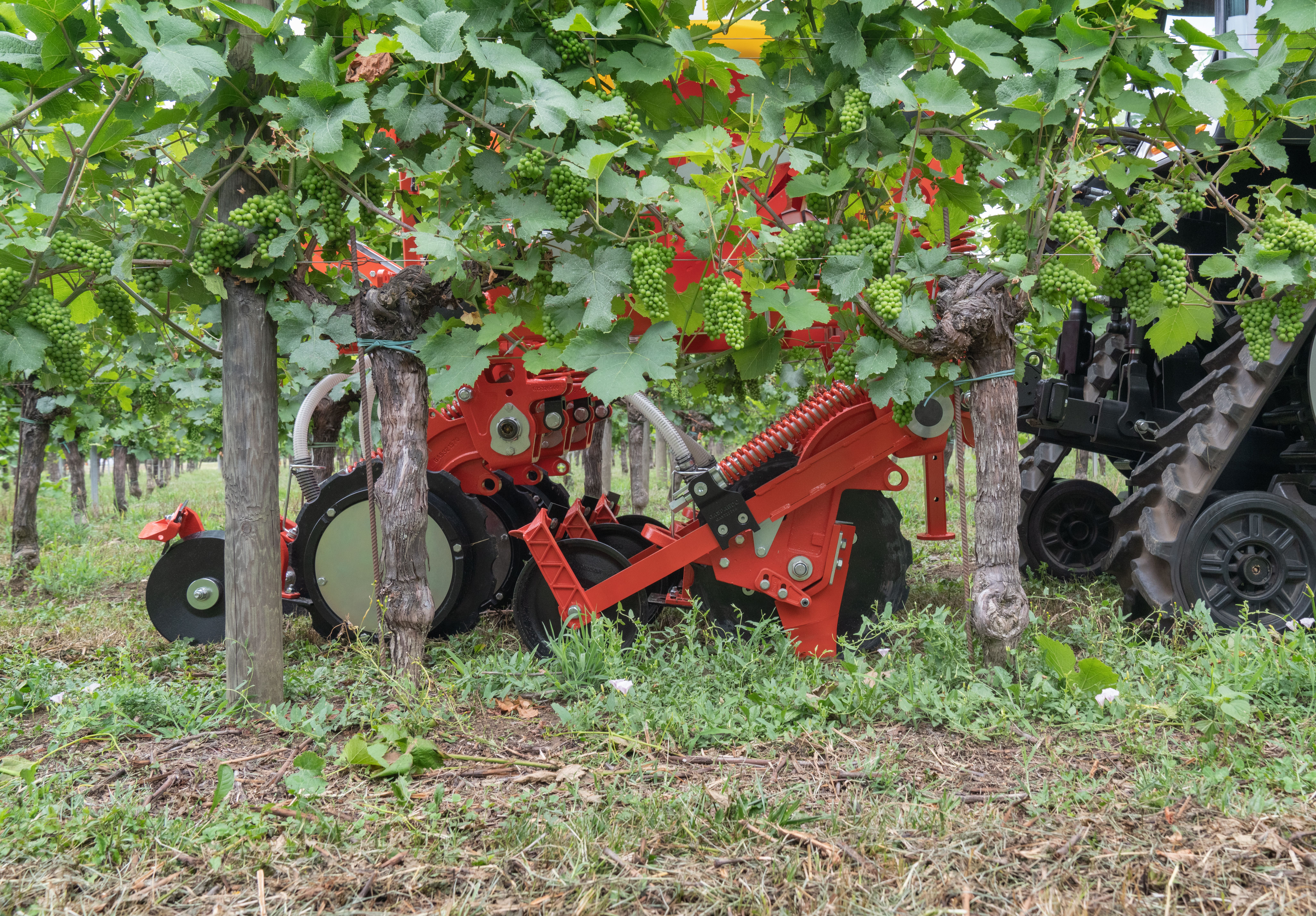Grassing is proving to be a very effective cultivation technique in the management of orchards and vineyards. Here are the modern technologies that facilitate its implementation
Among the cultivation techniques for orchards and vineyards, grassing is gaining ground with the creation of a herb of grasses and legumes, which will then be mowed down periodically or buried with the practice of green manure. It is, however, convenient to practice grassing where vines and fruit-bearing plants are less affected by competition with grass for water. The competition that the herbage develops with the fruit-bearing plants and the vine can, on the other hand, be advantageous in very fertile soils, as it leads to less vegetative growth of the cultivars and their lower productivity but higher sugar content. In addition, the essences of the grass must be chosen in consideration of the type of grassing: permanent or green manure. The latter involves burying the herbage to increase the organic substance in the soil, so the mixture to be sown must offer biomass quality, which will then translate into the quality of the organic substance that will be formed after burying. Among other things, it is worth considering sowing nematocidal essences such as brassica, horseradish and mustard to control nematodes, if present in the soil. Generally speaking, we would suggest a mixture of ryegrass and clover for green manure grass in order to combine the more stable transformation of grasses into humus with the faster transformation of leguminous plants. With regard to the permanent grassland, which will be mown periodically to control its growth, the most commonly used mixture of essences is composed of fescue, ryegrass and clover. Here, too, the combination of graminaceous and leguminous plants is practiced with all the advantages this entails. Among other things, clovers increase the nitrogen content of the soil thanks to their nitrogen-fixing capacity. However, the health of the seed is a key element, so the choice should be directed towards certified seed, leaving aside the selection of seed from seed companies.
In any case, grassing has considerable advantages, e.g. it increases the bearing capacity of the soil, thus facilitating the passage of agricultural machinery, it prevents soil erosion as soil particles are retained by the roots of plants, it increases biodiversity by facilitating pollination.
Grass sowing methods
Among the methods for sowing grass, the most modern contemplates the use of a seed drill for sowing grass, either permanent or for sowing. This seed drill, which is carried by the tractor’s rear three-point hitch, must be equipped with a sturdy frame with a small footprint to allow both transit between rows and manoeuvring at the end of rows. But what most enhances the effectiveness of the seed drill is the opener, which must be able to create the best conditions for seed germination. In this sense, the combined work of the 475 mm cutting disc with double inclination and the sickle bar opener is optimal.
With this device, the seeding depth is set thanks to a conical limiter applied externally to the disc, while a spring for adjusting the trim ensures a ground pressure of up to 160 kg. An independent oscillating arm with a truncated conical wheel that closes the seeding furrow completes the system. With regard to seed distribution, the most modern solution for seed drills entrusts this task to volumetric metering rollers with electric drive and pneumatic transport. Another very important system with which the seed drill must be equipped is electronic management, with the possibility of using the ISOBUS communication protocol that allows for manual or automatic dose variation and access to Agricoltura 4.0 incentives, as well as simplifying the operator’s work.
Another very good solution for grassing orchards and vineyards is the combination of a mechanical seed drill with a rotary harrow. We highlight the optimal characteristics of such a combination. The cantilevered position of the seed drill hopper on the rotary harrow results in a small footprint and a center of gravity very close to the tractor, ensuring site stability even in sloping areas. The rotary harrow with technical characteristics and robustness typical of large harrows ensures that it can work without problems in the tough, dry soil that characterizes high hillside orchards and especially vineyards. The tines positioned with a 15° offset allow progressive insertion into the soil, reducing the effort required from the tractor and thus lower fuel consumption and, in general, less wear of the components. The 25 cm spacing of the tine-holder shafts results in 4 rotors per metre, which guarantee optimal seedbed preparation even in tenacious and clayey soils. In turn, U-shaped tines that can be replaced with a single clamping nut facilitate maintenance. The extra-thick harrow housing profiles (6 mm) give the structure strength and neutralize torsional forces. The mechanical seed drill integrated into the rotary harrow must have distributors capable of handling both small and large seeds. The presence of a three-cam gearbox makes it possible to vary the seeding rate from 1 kg/ha to 500 kg/ha, thereby allowing the investment per unit area to be optimally balanced. The inlet pipes connected to the base of the hopper with a 78° drop angle ensure maximum distribution homogeneity, even on steeply sloping soils.
Even the integration of an electro-pneumatic seed drill with a rotary harrow creates an efficient work site capable of meeting the demands of work in very specialized contexts such as orchards and vineyards. Thus, the rotary harrow can be used to refine the soil between the rows of vines or orchards, and with the integration of an electro-pneumatic seed drill it allows the seedbed to be prepared and the grass mixture to be sown in a single pass. All this in order to improve agronomic and economic management of orchards and vineyards, also with a view to greater environmental sustainability.
Pier Luigi Scevola




